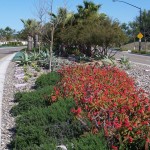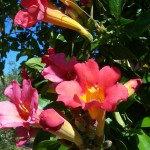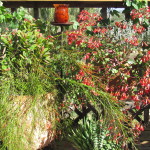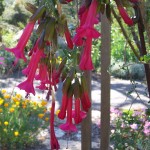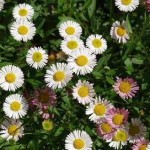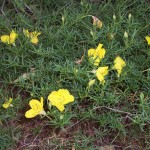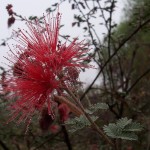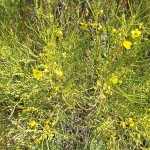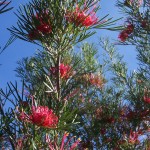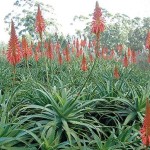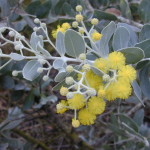I have a special predilection for the color Red: Not only does it become me as a blonde, it also fires up my mood, makes me cheerful and revs up my energy. I am drawn to Red like a hummingbird, and if Red on me invigorates me, I believe seeing red “lights” in the garden would do the same. Even in a garden space where the main hues are cooler and more restraint, and where there are lots of calmer tones in rocks, timber, pathways and other hardscape elements, a few red splashes warm up the planting scheme and make the tones more saturated. Red works particularly well in South-West style gardens, where it makes a lively contrast to lighter colors such as DG, sand or gravel whose tones look washed out in the strong sunlight; used as color on a background wall it adds drama to succulents and cacti.
Red can provide a bright focal point, such as a Bloodred Trumpet Vine Distictis buccinatoria drooping from a wall or from an arbor, or a Crown-of-Thorns Euphorbia milii, mixed with Firecracker Broom Russelia equisitiformis, spilling from an urn. Used as accent plant in the background, such as in groupings of red-flowering Aloe behind shorter, softer perennials or clumping succulents, the Aloe’s red flower spikes will show like exclamation points, and their pointy leaves will create a dynamic contrast in structure and texture.
When planted in the foreground as border accent, or hugging the curves of a path, Red creates a bright ribbon through the garden that your eye can follow; as foreground plant repeated throughout the garden it ties different areas together and adds cohesion.
If used as red winter bloomer, f.e. Cyclamen Cyclamen persicum, it will bring much needed warmth into your planter beds, and in dark and shady places the red flowers will shine like lights.
I am having fun doing this and have compiled lists of plants with red flowers that I like to use. Of course each landscape prompts a different choice because of its design style, its existing sun/shade conditions, its soil type, the character of the architecture and the hardscape materials chosen. The following compilation of “Reds” contains plants with various growing conditions, but all are long-lived, low in maintenance needs and more or less water-wise and tolerant of xeric conditions. (However, it’s important to note that a plant’s location will determine how tolerant of dry conditions it is: For example, a Crangrape Cuphea C. llavea “Crangrape” is more drought tolerant in coastal locations and soils than in hotter inland valleys.) Nor is the list all-inclusive, and if you have more suggestions, I will be happy to add them.
THE SHORT & MEDIUM STUFF FOR SUN & PARTIAL SHADE
Aloes (many): Aloe ‘rookappie’, Aloe saponaria, Aloe arborescens, Aloe nobilis
Autumn Sage & relative Dwarf Crayon Sage Salvia greggii, S. grahamii
Baja Fairy Duster Calliandra californica & Fairy Duster Calliandra erophylla
Blanket Flower Gaillardia grandiflora
Bottlebrush Callistemon citrinus and C. viminalis
Butterfly Weed Asclepias tuberosa
Cantua ‘Hot Pants’ Cantua buxifolia
Chuparosa Justicia californica
Coral Bells Heuchera sanguinea, Heuchera micrantha
Croscosmia
Crown-of-Thorns Euphorbia millii
Emu Bush ‘Valentine’ Eremophila species ‘Valentine’
Royal Beard Tongue Penstemon spectabilis
Firecracker Penstemon Penstemon eatonii
Grevilleas ‘Poorinda Constance” , Grevillea lanigera
Kalanchoe Kalanchoe blossfeldiana & Kalanchoe manganii
Kangaroo Paw “Bush Blaze” & “Sunset”, Anigozanthus flavidus
Many Daylilies: Red Hot Poker, Cardinal Spokes Hemerocallis hybrids
Nodding Pincushion Leucospermum cordifolium
Propeller Plant Crassula falcata
Red Hot Poker Plant Kniphophia uvaria
Sticks on Fire Euphorbia tirucalli
Watsonia Watsonia intermedia
Zonal Geranium Pelargonium hortorum
(See also my previous article “Exceptional Winter Blooming Plants for Southern California”)
RED-FLOWERING TREES
Here only an incomplete list:
Australian Flame Tree Brachychiton acerifolius
Coral Trees Erythrina x bidwillii, E. caffra, E. coralloides etc.
Crape Myrtle “Watermelon Red” and “Tonto” Lagerstroemia indica & Lagerstroemia x hybrids
Firewheel Tree Stenocarpus sinuatus
Mimosa, Silk Tree Albizia julibrissin
